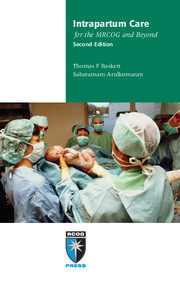Book contents
- Frontmatter
- Contents
- Preface
- Abbreviations
- 1 Improving intrapartum care
- 2 First stage of labour
- 3 Second stage of labour
- 4 Fetal surveillance in labour
- 5 Third stage of labour
- 6 Lower genital tract trauma
- 7 Induction of labour
- 8 Preterm labour and prelabour rupture of membranes
- 9 Assisted vaginal delivery
- 10 Shoulder dystocia
- 11 Breech vaginal delivery
- 12 Twin and triplet delivery
- 13 Caesarean section
- 14 Vaginal birth after caesarean section
- 15 Uterine rupture
- 16 Emergency obstetric hysterectomy
- 17 Cord prolapse
- 18 Antepartum haemorrhage
- 19 Postpartum haemorrhage
- 20 Acute uterine inversion
- 21 Amniotic fluid embolism
- 22 Disseminated intravascular coagulation
- 23 Acute tocolysis
- 24 Severe pre-eclampsia and eclampsia
- 25 Neonatal resuscitation
- 26 Perinatal loss: management of late fetal death and stillbirth
- Index
5 - Third stage of labour
Published online by Cambridge University Press: 05 July 2014
- Frontmatter
- Contents
- Preface
- Abbreviations
- 1 Improving intrapartum care
- 2 First stage of labour
- 3 Second stage of labour
- 4 Fetal surveillance in labour
- 5 Third stage of labour
- 6 Lower genital tract trauma
- 7 Induction of labour
- 8 Preterm labour and prelabour rupture of membranes
- 9 Assisted vaginal delivery
- 10 Shoulder dystocia
- 11 Breech vaginal delivery
- 12 Twin and triplet delivery
- 13 Caesarean section
- 14 Vaginal birth after caesarean section
- 15 Uterine rupture
- 16 Emergency obstetric hysterectomy
- 17 Cord prolapse
- 18 Antepartum haemorrhage
- 19 Postpartum haemorrhage
- 20 Acute uterine inversion
- 21 Amniotic fluid embolism
- 22 Disseminated intravascular coagulation
- 23 Acute tocolysis
- 24 Severe pre-eclampsia and eclampsia
- 25 Neonatal resuscitation
- 26 Perinatal loss: management of late fetal death and stillbirth
- Index
Summary
The third stage of labour lasts from the birth of the infant until delivery of the placenta. It usually lasts for 5–10 minutes and rarely more than 30 minutes. Although it is the shortest of the three stages of labour, it carries the greatest potential risk for the mother.
Physiology
After delivery of the infant, the uterus continues to contract rhythmically. The muscle fibres of the uterus, which have stretched considerably to accommodate the fetus, are shortened dramatically by these contractions and sustained by retraction. Retraction is the property, unique to the uterus, by which muscle fibre length is permanently shortened after the active, energy-consuming contraction has passed.
PLACENTAL SEPARATION
Contraction and retraction of the uterine muscle cause a progressive reduction in the size of the placental implantation site. Thus, the relatively inelastic placenta buckles and is sheared from the uterine wall. An additional but much less significant role involves compression of the decidual veins by the uterine contraction, while the spiral arteries continue to pump blood into the intervillous space. This extravasation of blood helps dissect through the decidua spongiosa layer. Once the placenta has physically separated from the uterine wall, the myometrial contractions assist the passage of the placenta from the uterine cavity, through the cervix and into the upper vagina.
- Type
- Chapter
- Information
- Intrapartum Care for the MRCOG and Beyond , pp. 51 - 62Publisher: Cambridge University PressPrint publication year: 2011



